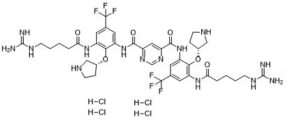Brilacidin tetrahydrochloride
This product is for research use only, not for human use. We do not sell to patients.

For small sizes, please check our retail website as below: www.invivochem.com
| Size | Price | Stock |
|---|---|---|
| 100mg | $1350 | Check With Us |
| 200mg | $2025 | Check With Us |
| 500mg | $3415 | Check With Us |
Cat #: V17030 CAS #: 1224095-99-1 Purity ≥ 99%
Description: Brilacidin tetrahydrochloride (PMX-30063; PMX 30063) is a novel and potent arylamide foldamer that can mimic the amphiphilic properties of antimicrobial peptides.
Top Publications Citing Invivochem Products
Publications Citing InvivoChem Products
Product Promise

- Physicochemical and Storage Information
- Protocol
- Related Biological Data
- Stock Solution Preparation
- Quality Control Documentation
| Molecular Weight (MW) | 1082.75 |
|---|---|
| Molecular Formula | C40H54Cl4F6N14O6 |
| CAS No. | 1224095-99-1 |
| SMILES Code | O=C(C1=NC=NC(C(NC2=CC(C(F)(F)F)=CC(NC(CCCCNC(N)=N)=O)=C2O[C@H]3CNCC3)=O)=C1)NC4=CC(C(F)(F)F)=CC(NC(CCCCNC(N)=N)=O)=C4O[C@H]5CNCC5.[H]Cl.[H]Cl.[H]Cl.[H]Cl |
| Synonyms | Brilacidin HCl; Brilacidin tetrahydrochloride; PMX30063; PMX-30063; PMX 30063; Brilacidin; |
| Protocol | In Vitro | Both Staphylococcus aureus (SA) and Staphylococcus epidermidis (SE) have the lowest minimum inhibitory concentrations among the bacterial groups. The MIC90s to Brilacidin for Streptococcus pneumonia (SP), Streptococcus viridians (SV), Moraxella (MS), Haemophilus influenza (HI), Pseudomonas aeruginosa (PA), and Serratia marcescens (SM) are 4, 32, 256, 32, 16, and 128-fold higher, respectively, than SA and SE. Brilacidin has Gram-positive in vitro activity; topical Brilacidin 0.5% is minimally irritating; and Brilacidin 0.5% was equally efficacious as Vancomycin (VAN) in a methicillin-resistant S. aureus (MRSA) keratitis model when the corneal epithelium is removed. Brilacidin acts primarily on the bacterial cell membrane by depolarization. Brilacidin is more potent for Gram-positive bacteria (except SV) than Gram-negative bacteria. |
|---|---|---|
| In Vivo | Brilacidin demonstrates dose-dependent ocular toxicity after 7 topical instillations (every 30 min for 3 h) in the NZW rabbit ocular toxicity model. Brilacidin 1% is determined to be Mildly Irritating (23.0), Brilacidin 0.5% (6.5), and Brilacidin 0.25% (4.0) are determined to be Minimally Irritating, while Brilacidin 0.1% (2.0) and TBS (1.0) are determined to be Practically Nonirritating and 0.01% Brilacidin (0.5) is determined to be Nonirritating based on their Maximum mean total scores (MMTS) values. |
These protocols are for reference only. InvivoChem does not
independently validate these methods.
| Solvent volume to be added | Mass (the weight of a compound) | |||
|---|---|---|---|---|
| Mother liquor concentration | 1mg | 5mg | 10mg | 20mg |
| 1mM | 0.9236 mL | 4.6179 mL | 9.2357 mL | 18.4715 mL |
| 5mM | 0.1847 mL | 0.9236 mL | 1.8471 mL | 3.6943 mL |
| 10mM | 0.0924 mL | 0.4618 mL | 0.9236 mL | 1.8471 mL |
| 20mM | 0.0462 mL | 0.2309 mL | 0.4618 mL | 0.9236 mL |
The molarity calculator equation
Mass(g) = Concentration(mol/L) × Volume(L) × Molecular Weight(g/mol)
Mass
=
Concentration
×
Volume
×
Molecular Weight*
The dilution calculator equation
Concentration(start)
×
Volume(start)
=
Concentration(final)
×
Volume(final)
This equation is commonly abbreviated as: C1 V1 = C2 V2
Concentration(start)
C1
×
Volume(start)
V1
=
Concentration(final)
C2
×
Volume(final)
V2
Step One: Enter information below
Dosage mg/kg
Average weight of animals g
Dosing volume per animal µL
Number of animals
Step Two: Enter the in vivo formulation
%DMSO
+
%
+
%Tween 80
+
%ddH2O
Calculation Results:
Working concentration:
mg/ml;
Method for preparing DMSO master liquid:
mg
drug pre-dissolved in
µL
DMSO(Master liquid concentration
mg/mL)
,Please contact us first if the concentration exceeds the DMSO solubility of the batch of drug.
Method for preparing in vivo formulation:
Take
µL
DMSO master liquid, next add
µL
PEG300, mix and clarify, next add
µL
Tween 80,mix and clarify, next add
µL
ddH2O,mix and clarify.
Note:
- (1) Please be sure that the solution is clear before the addition of next solvent. Dissolution methods like vortex, ultrasound or warming and heat may be used to aid dissolving.
- (2) Be sure to add the solvent(s) in order.




































